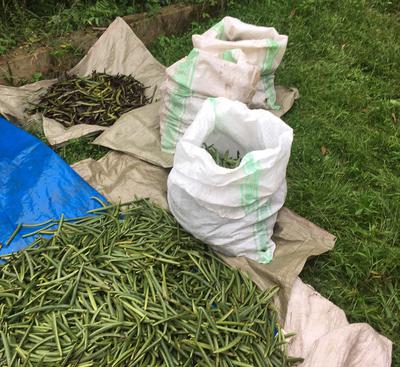VANILLA BEANS | SOYBEAN OIL | SOYA CAKE | COCOA BEANS | COFFEE BEANS
As Global Vanilla Prices Hit the USD700/Kg Mark in 2018 - Uganda seems motivated enough to become a significant supplier going forward

Uganda Vanilla Beans ready for Curing 2018
As global Vanilla Prices are hitting an all Time High Mark of close to USD700 per Kg , Uganda stands a chance once again to participate significantly in this market.
On ground here in Uganda we're seeing a lot of media Sensitization about Vanilla growing and Emphasis being put on the quality of beans, which I'm happy about.
We're also seeing farmers more vigilant with regard to security of their gardens within the Vanilla growing regions and also police officers on the road seem to be more interested about Vanilla being transported. The only problem I see happening on the roads is that some law enforcers a taking advantage of the ongoing Vanilla security strengthening to extort money from Vanilla buyers.
Contact us here to make an order for Uganda Vanilla Beans.
We're also seeing more Ugandans taking up Vanilla growing, though unfortunately these new plants will not have any impact on the industry price until some 3-4 years to come.
The articles below will help you get some more understanding of how the global vanilla industry is playing out this year:
Article #1: By JULIE VAN ROSENDAAL
SPECIAL TO THE GLOBE AND MAIL
PUBLISHED MARCH 11, 2018
---------------------------
When it comes time to replace that little bottle of vanilla in your pantry, prepare for some sticker shock.
"When we opened Provisions four years ago, we were selling a 4 oz bottle of vanilla-bean paste for $5.75, and now we sell it for $32," says Giselle Courteau, who owns the popular Duchess Bake Shop, as well as a small high-end store for home bakers next door called Provisions, in Edmonton.
Vanilla is a staple in any baker's pantry, but a recent confluence of events – a "perfect storm" – has led to an unprecedented spike in prices, with the cost of the ingredient rising to almost 20 times as much as it did a few years ago. A kilo is now $700, up from $40 in 2011, reports David van der Walde, director of Aust & Hachmann Canada, a Montreal-based vanilla importing company affiliated with the oldest vanilla importers in the world. It is now the second-most expensive spice in the world, after saffron.
Contact us here to make an order for Uganda Vanilla Beans.
The food industry has found itself scrambling to find affordable solutions, while vanilla growers face new challenges. And some restaurateurs now report an underground market for the ingredient has emerged.
"People think vanilla is so plain, so simple," says van der Walde, "but it's probably the most complicated flavour out there." The raw material for this wildly popular flavouring is not easily obtained. Vanilla is a high-risk, labour-intensive product; derived from orchids, each flower must be hand-pollinated, and the crops themselves are particularly susceptible to vine disease and storms before the pods are harvested by hand and cured in small batches using traditional methods.
Read this Full article here.
Article #2: By ELIZABETH GREEN
------------------------------
As vanilla continues to be in demand and proves to be a global flavor of the century, the conversation quickly shifted to the challenges on the supply side for the vanilla bean. “As an industry, the price of vanilla is at an all-time high,” says Nielsen. “Prices have been high for the last couple of years and will probably remain so for at least this year and potentially into 2019, depending on the demand and the quality of the crop.”
“Every ten to fifteen years, we have some crisis around supply and pricing of vanilla. The last one occurred from 1999 to 2014-5. After that, we did have a period of stability with good quality and supply from 2006-2014. Since 2015, we have seen an increased demand for natural vanilla and a lot of that was created by the CPG’s announcing they were taking the artificial flavors out of their products,” he explains.
Contact us here to make an order for Uganda Vanilla Beans.
“Increased demand can create a shortage. Vanilla vines need three to four years to be planted and to grow before they produce anything. Madagascar supplies 80 percent of the vanilla to the market, but there has been some progress in other vanilla-growing regions, such as Uganda and Indonesia. We source most of our vanilla from Madagascar, but we also do buy from Mexico and Tahiti.”
“You have the major areas producing vanilla, but we see some smaller production starting in different areas, such as Tanzania, Costa Rica and Guatemala. This is a way of potentially looking at newer sources and their supply potential,” Nielsen adds.
Read this full vanilla Article here.
Contact us here to make an order for Uganda Vanilla Beans.
Join in and write your own page! It's easy to do. How? Simply click here to return to Plants Guide.
If you haven't yet found what you were looking for or you need detailed information about the subject matter on this page then... feel free to ask our business travel consultants. |




